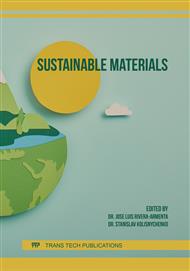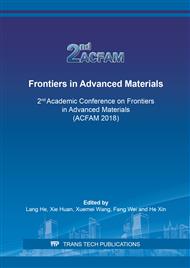[1]
M.M. Doeff, Y.P. Ma, S.J. Visco, L.C.D. Jonghe, Electrochemical Insertion of Sodium into Carbon, J. Electrochem. Soc. 140 (1993) 169-170.
DOI: 10.1149/1.2221153
Google Scholar
[2]
V. Palomares, P. Serras, I. Villaluenga, K.B. Hueso, G.J. Carretero, T. Rojo, Na-ion batteries, recent advances and present challenges to become low cost energy storage systems, Energy Environ. Sci. 5 (2012) 5884-5901.
DOI: 10.1039/c2ee02781j
Google Scholar
[3]
L. Ji, M. Gu, Y. Shao, X. Li, Controlling SEI formation on SnSb-porous carbon nanofibers for improved Na ion storage, Adv. Mater. 26 (2014) 2901-2908.
DOI: 10.1002/adma.201304962
Google Scholar
[4]
Y. Liu, F. Fan, J. Wang, Y. Liu, H. Chen, K.L. Jungjohann, Y. Xu, Y. Zhu, D. Bigio, T. Zhu, In situ transmission electron microscopy study of electrochemical sodiation and potassiation of carbon nanofibers, Nano Lett. 14 (2014) 3445-3452.
DOI: 10.1021/nl500970a
Google Scholar
[5]
F. Hu, J. Wang, S. Hu, L. Li, W. Shao, J. Qiu, Z. Lei, W. Deng, X. Jian, Engineered fabrication of hierarchical frameworks with tuned pore structure and N, O-co-doping for high-performance supercapacitors, ACS Appl. Mater. Interfaces. 9 (2017) 31940-31949.
DOI: 10.1021/acsami.7b09801
Google Scholar
[6]
C. Delmas, J.J. Braconnier, C. Fouassier, P. Hagenmuller, Electrochemical intercalation of sodium in NaxCoO2 bronzes, Solid State Ion. 3 (1981) 165-169.
DOI: 10.1016/0167-2738(81)90076-x
Google Scholar
[7]
H.G. Jung, M.W. Jang, J. Hassoun, Y.K. Sun, B. Scrosati, A high-rate long-life Li4Ti5O12/Li[Ni0.45Co0.1Mn1.45]O4 lithium-ion battery, Nat. Commun. 2 (2011) 516.
DOI: 10.1038/ncomms1527
Google Scholar
[8]
J. Ding, Z. Li, K. Cui, S. Boyer, D. Karpuzov, D. Mitlin, Heteroatom enhanced sodium ion capacity and rate capability in a hydrogel derived carbon give record performance in a hybrid ion capacitor, Nano Energy. 23 (2016) 129-137.
DOI: 10.1016/j.nanoen.2016.03.014
Google Scholar
[9]
M. Asadi, B. Sayahpour, P. Abbasi, A.T. Ngo, K. Karis, J.R. Jokisaari, C. Liu, B. Narayanan, M. Gerard, P. Yasaei, A lithium–oxygen battery with a long cycle life in an air-like atmosphere, Nature. 555 (2018) 502-506.
DOI: 10.1038/nature25984
Google Scholar
[10]
H. Hou, L. Shao, Y. Zhang, G. Zou, J. Chen, X. Ji, Large-Area Carbon Nanosheets Doped with Phosphorus: A High-Performance Anode Material for Sodium-Ion Batteries, Adv. Sci. 4 (2016) 1600243.
DOI: 10.1002/advs.201600243
Google Scholar
[11]
Y. Yang, W. Shi, R. Zhang, C. Luan, Q. Zeng, C. Wang, S. Li, Z. Huang, H. Liao, X, Ji, Electrochemical Exfoliation of Graphite into Nitrogen-doped Graphene in Glycine Solution and its Energy Storage Properties, Electrochim. Acta. 204 (2016) 100-107.
DOI: 10.1016/j.electacta.2016.04.063
Google Scholar
[12]
H. Xu, J. Chen, D. Wang, Z. Sun, P. Zhang, Y. Zhang, X. Guo, Hierarchically porous carbon-coated SnO2@graphene foams as anodes for lithium ion storage, Carbon. 124 (2017) 565-575.
DOI: 10.1016/j.carbon.2017.09.016
Google Scholar
[13]
Y. Zhu, X. Han, Y. Xu, Y. Liu, C. Wang, Toward advanced sodium-ion batteries: a wheelinspired yolk–shell design for large-volumechange anode materials, J. Mater. Chem. A. 6 (2018) 13153-13163.
DOI: 10.1039/c8ta03772h
Google Scholar
[14]
H. Xu, J. Chen, D. Wang, Z. Sun, P. Zhang, Y. Zhang, X. Guo, Significant impact of 2D graphene nanosheets on large volume change tin-based anodes in lithium-ion batteries: A review, J. Power Sources. 274 (2015) 869-884.
DOI: 10.1016/j.jpowsour.2014.10.008
Google Scholar
[15]
D.A. Stevens, J.R. Dahn, High Capacity Anode Materials for Rechargeable Sodium-Ion Batteries, J. Electrochem. Soc. 147 (2000) 1271-1273.
DOI: 10.1149/1.1393348
Google Scholar
[16]
S. Kim, C.B. Park, Bio-Inspired Synthesis of Minerals for Energy, Environment, and Medicinal Applications, Adv. Funct. Mater. 23 (2013) 10-25.
DOI: 10.1002/adfm.201201994
Google Scholar
[17]
H. Hou, C.E. Banks, M. Jing, Y. Zhang, X. Ji, Carbon Quantum Dots and Their Derivative 3D Porous Carbon Frameworks for Sodium-Ion Batteries with Ultralong Cycle Life, Adv. Mater. 27 (2015) 7861-7866.
DOI: 10.1002/adma.201503816
Google Scholar
[18]
E.M. Lotfabad, J. Ding, K. Cui, A. Kohandehghan, W.P. Kalisvaart, M. Hazelton, D. Mitlin, High-density sodium and lithium ion battery anodes from banana peels, ACS Nano. 8 (2015) 7115-29.
DOI: 10.1021/nn502045y
Google Scholar
[19]
F. Hu, J. Wang, S. Hu, L. Li, G. Wang, J. Qiu, X. Jian, Inherent N, O-containing carbon frameworks as electrode materials for high-performance supercapacitors, Nanoscale. 8 (2016) 16323-16331.
DOI: 10.1039/c6nr05146d
Google Scholar
[20]
H. Wang, D. Mitlin, J. Ding, Z. Li, K. Cui, Excellent energy – power characteristics from a hybrid sodium ion capacitor based on identical carbon nanosheets in both electrodes, J. Mater. Chem. A. 4 (2016) 5149-5158.
DOI: 10.1039/c6ta01392a
Google Scholar
[21]
J. Chen, J. Xu, S. Zhou, N. Zhao, C. Wong, Nitrogen-doped hierarchically porous carbon foam: A free-standing electrode and mechanical support for high-performance supercapacitors, Nano Energy. 25 (2016) 193-202.
DOI: 10.1016/j.nanoen.2016.04.037
Google Scholar
[22]
C. Portet, G. Yushin, Y. Gogotsi, Electrochemical performance of carbon onions, nanodiamonds, carbon black and multiwalled nanotubes in electrical double layer capacitors, Carbon. 45 (2007) 2511-2518.
DOI: 10.1016/j.carbon.2007.08.024
Google Scholar
[23]
J. Ding, H. Wang, Z. Li, K. Cui, D. Karpuzov, X. Tan, A. Kohandehghan, D.M. Alireza, Peanut shell hybrid sodium ion capacitor with extreme energy–power rivals lithium ion capacitors, Energy Environ. Sci. 8 (2015) 941-955.
DOI: 10.1039/c4ee02986k
Google Scholar
[24]
Y.L. Cheah, V. Aravindan, S. Madhavi, Electrochemical Lithium Insertion Behavior of Combustion Synthesized V2O5 Cathodes for Lithium-Ion Batteries, J. Electrochem. Soc. 159 (2012) A273-A280.
DOI: 10.1149/2.071203jes
Google Scholar
[25]
W.J. Cao, J.P. Zheng, Li-ion capacitors with carbon cathode and hard carbon/stabilized lithium metal powder anode electrodes, J. Power Sources. 213 (2012) 180-185.
DOI: 10.1016/j.jpowsour.2012.04.033
Google Scholar



